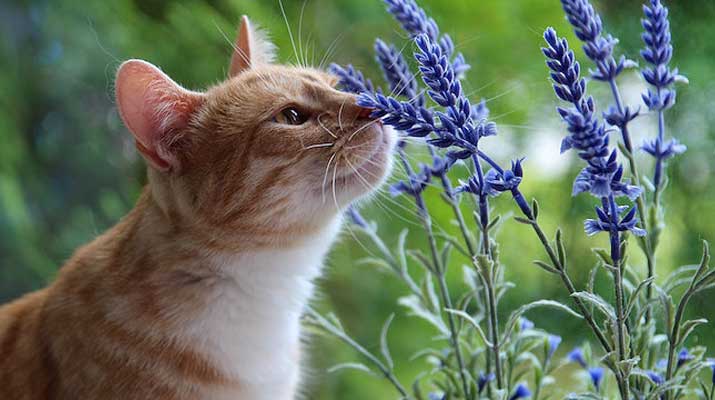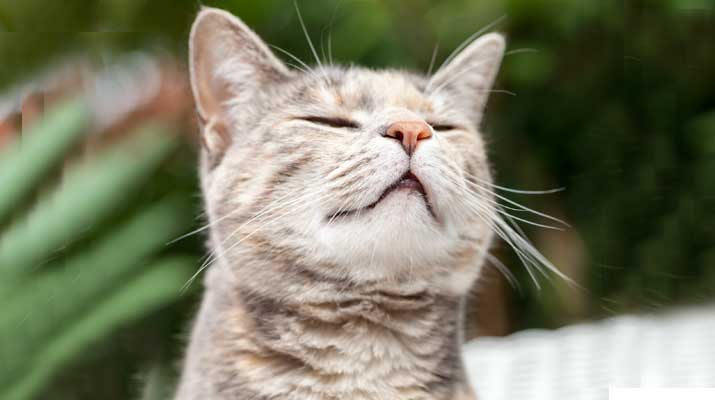When most people think of animals with an impeccable sense of smell, the first creature that comes to mind is a dog. While canines certainly rely on their noses for many things, they’re not the only ones with impressive olfactory senses!

Cats have powerful smelling abilities, too. Open up a can of wet food or tuna, and your feline friend will likely come out of nowhere the moment the scent hits the air!
You may even see them grimace at a dirty litter box or go crazy at a subtle waft of catnip! Those situations prove that cats are far more sensitive to smells than we humans are.
But exactly how far can cats smell?
How Far Can Cats Smell Odors?
Here’s the million-dollar question! There’s no way to know for sure. All cats are different, and many factors contribute to how these animals smell the world.
That said, experts believe that cats have a sense of smell that is roughly 14 times stronger than a human’s. That means they can detect odors from considerable distances.
Generally, cats can smell their food from 126 to 154 feet away. That’s why cats seem to notice its feeding time despite being on the other side of the house.
The moment you crack open that can or unfurl the bag of kibble, the scent wafts through the air to alert your feline friend.
The same principle applies to unsavory smells like a dirty litter box. Cats can usually smell those malodorous objects from a couple of hundred feet away.
The most impressive part of a cat’s sense of smell is its homing instinct. Have you ever wondered how cats always seem to make their way home?
Even if they’re gone for a few days, they never fail to show up at your house again. Cats use several unique biological functions to find their way home. Smell is just one of them!
Scientists believe that cats can navigate home at distances between 1.5 to 4 miles. It’s doubtful that they can smell you or their favorite items all that way. But, they might detect pheromones and other markers as they get closer.
Factors That Impact Smell Detection
Up to 154 feet away is the general consensus of a cat’s ability to smell great distances. But of course, no environment is perfect. Several factors can extend or shorten a cat’s ability to detect odors.
Remember: Smelling involves odor molecules. It doesn’t matter whether your cat is detecting a smell emanating from food or they’re trying to pick up pheromone signals.
Both processes involve physical molecules that have to make their way to the relevant receptors. Otherwise, your cat can’t sense anything!
The first thing that impacts how far a cat can smell is the overall potency of the odor. Some items give off a more potent smell than others.
For example, cats can usually detect when you open up a bag of dry kibble from across the house. But if you’re feeding wet food, they might smell it from outside.
Wet foods like canned tuna are more aromatic, causing tons of those odor molecules to go airborne.
Another factor to consider is wind. Odor particles have a very low molecular weight. It doesn’t take much to move them. In strong winds, those smells could travel significant distances to notify cats.
Understanding How Cats Smell
For some clear insight into how strong a cat’s sense of smell is, let’s look into how they use their noses in the first place.
Interestingly enough, cats use two different mechanisms to pick up on scents.These include the standard olfactory receptors and a unique vomeronasal organ.
About the Olfactory Receptors
Cats use their sniffers just like humans and other mammals. However, felines have unique biology that makes their smelling capabilities nothing short of impressive.
Nasal olfactory receptors play a crucial role in a cat’s ability to smell.
The receptors are small binding proteins that line the nasal cavity. Their job is to capture information about smells and send them to the brain for analysis. Sounds simple enough, right?

We use the same process, but odors take a fascinating journey for cats to understand them.
It all starts with the odor molecules. You can’t see them, but smells typically come from organic compounds.
The molecules enter your cat’s nose when they inhale. Once inside, the molecules dissolve into the mucus lining the nasal cavity. That’s right! Mucus has a purpose!
Olfactory cells move the molecule-infused mucus towards the olfactory receptors. The cells have finger-like protrusions to move things along. This all happens on a molecular level, so your cat doesn’t feel a thing despite the movement.
Eventually, those odor molecules make their way to the olfactory receptors. They bind to the receptors, triggering a chemical signal to the brain.
The brain processes the smell, and voila! Your cat gets a better idea of what they’re smelling.
What’s the Vomeronasal Organ?
Here’s where cats are vastly different from humans. Felines take full advantage of a vomeronasal organ on the roof of their mouth. It’s also known as “Jacobson’s Organ.”
Think of it as a tiny discrete nose. But instead of smelling traditional odors, the vomeronasal organ picks up pheromones.
Ever wonder how cats, dogs, and other animals communicate non-verbally? In most cases, they use pheromones. That’s why cats go crazy when they come across another animal’s poop or urine spot.
That area is likely flush with pheromones that your cat can easily pick up. You might not smell a thing, but your feline friend is picking up tons of unsaid information.

Cats all have a distinct pheromone marker. It’s how these creatures claim territory. When they enter a space that’s not theirs, most cats will know it.
Many felines also use their pheromones for other purposes.
Do you know that seemingly affectionate body rub your cat does? Hate to break it to you, but your cat is likely focused on spreading its pheromones onto you rather than showing affection. Don’t worry:
The fact that they’re trying to claim you shows plenty of love, albeit in a quirky way!
Pheromones also play a part in mating rituals and other social interactions.
How Does it Work?
So, how does the vomeronasal organ work? It’s similar to the olfactory receptors. A cluster of sensory cells and receptors sit on the roof of the mouth.
When those pheromones waft through the air, they flow into your cat’s mouth and dissolve into the saliva. Then, the molecules bind to the receptors before the brain receives a message about the pheromones.
The unique placement of the vomeronasal organ leads to odd faces you might have noticed at some point.
The Flehmen Response
Cats must open their mouth to take in the pheromones. Not only that, but they must move the saliva to the receptors in the vomeronasal organ.
As a result, cats often move their tongue to the roof of the mouth.
A gaping mouth and wide-open eyes can make your cat look like they’re confused or grimacing. The facial expression is known as the Flehmen response, and it’s your cat’s way of getting a whiff of nearby pheromones!
Cats aren’t the only ones with vomeronasal organs. Dogs have one, too. The same goes for snakes, lizards, and other reptiles.
Believe it or not, humans have one as well! It’s in the nasal septum. But before you start sniffing around for pheromones, the human vomeronasal organ is vestigial and non-functioning.
How Powerful is a Cat’s Sense of Smell?
Cats have a very powerful sense of smell. It’s stronger than most people realize, and some zoologists believe that it’s more fine-tuned than even a dog’s.

Just how powerful is it?
Remember those nasal olfactory receptors we discussed? Experts say that cats have between 45 and 80 million receptors in their noses!
Some cats might have as many as 200 million! That’s a staggering amount!
For perspective, humans have roughly five million olfactory receptors. Cats have as many as 14 times more receptors than we do.
For this reason, cats perceive smells much differently than humans do. They might smell similar things, but they can detect odors from much farther.
Not only that, but their ability to pick up pheromones makes them more attuned to their surroundings. Next time you see your cat acting erratically out of nowhere, there’s a good chance it has to do with something they smell.
Related: 10 Scents that Repel Cats
Feline Evolution
Cats are pretty spoiled nowadays. Housecats don’t have to worry about how they’re getting their next meal or where they will take shelter for the night.
However, they retain many of the traits their wild ancestors have. The strong feline sense of smell is just one of them.
In the wild, a cat’s sense of smell and ability to pick up pheromones are crucial to their survival. Whether it’s a massive panther or a tiny housecat, felines are natural predators.
They’re hunters that lurk in the shadow and stalk their prey until the opportune time to attack.
If given a chance, even your spoiled cat at home will exhibit some of that hunting behavior.
The strong sense of smell is a product of genetics. It’s passed on to the next generation. While modern housecats do not need those impressive smelling capabilities, they remain nonetheless.
How Much Does a Cat Rely on Their Sense of Smell?
Sense of smell is just one way that cats navigate the world. We already know that their capabilities are far greater than ours. But how does it compare to their other senses?
The weakest sense that cats have to deal with is taste. Considering how much they go crazy over strong smells, it’s a shame!
Cats simply cannot taste the same things we do. They have a few hundred taste receptors on their tongue. For comparison, humans have about 9,000.
Interestingly, cats can’t taste sweet things. Some believe that the lack of sweet receptors is a product of random genetic mutation. However, it’s likely a good thing.
Their inability to taste sweets prevents them from indulging in sweet plants and berries.
Other than their sense of taste, cats have refined senses all around.
Their sense of sight is unique. Cats can detect motion and see shapes, but their vision isn’t nearly as good as their smelling ability. During the day, a cat’s vision is downright miserable. They can’t see all of the colors humans do.
That said, there is a tradeoff. Cats can see ultraviolet light. They also have pupils that can expand significantly to allow as much light into the eye as possible. This feature provides better visibility at night.
Finally, there’s touch. Cats rely on their whiskers to feel around. The whiskers are highly sensitive. They can pick up minute air pressure changes.
If you ever see your cat staring into the distance with its whiskers perked up, it’s likely checking things out and getting a good feel for the environment.
In addition to the whiskers, cats have touch receptors all over the body. The most noticeable are in areas where cats like to be touched.
Conclusion
While dogs get all the attention for their powerful sniffers, cats aren’t too far behind. Their sense of smell is approximately 14 times stronger than a human.
They use those powers to navigate the world, communicate through pheromones, and hunt down prey.
Next time you try to sneak a snack by your cat, know that they probably smelled whatever you’re eating long before you got near!
Also read:
- My Cat Smells Like Poop: 6 Causes & Solutions
- Why Do Cats Roll in the Dirt?
- Why Cats Stick Their Tongues Out

